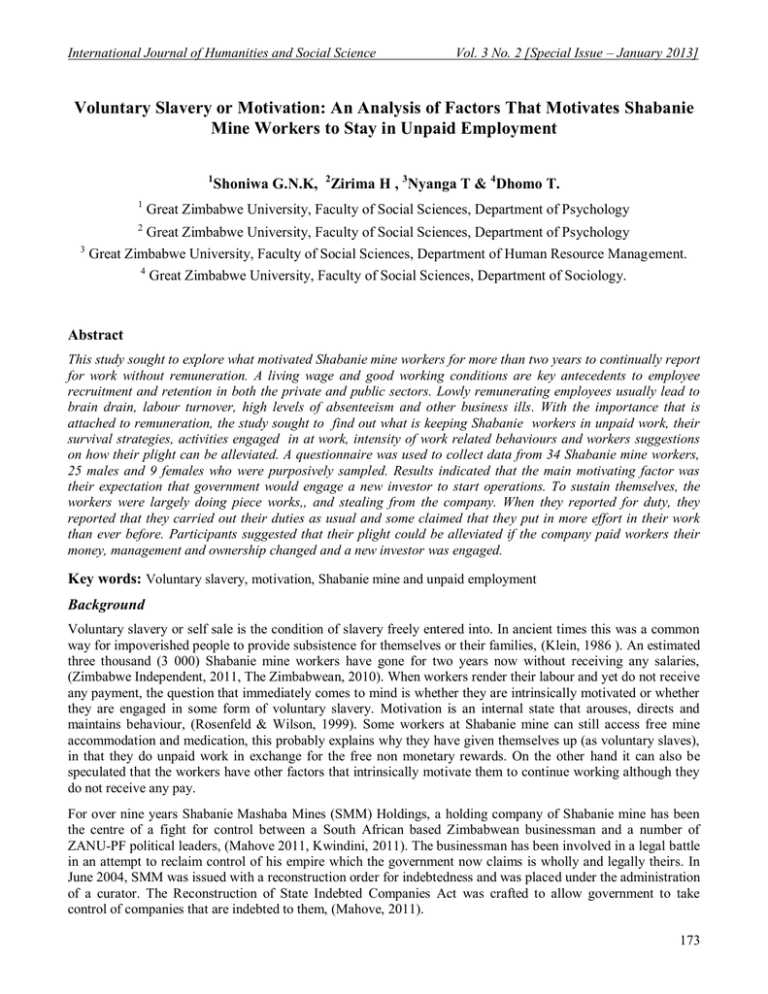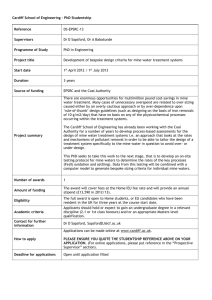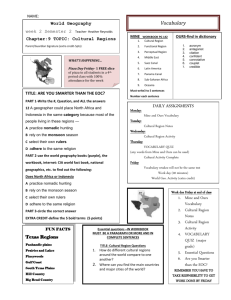Document 10464913
advertisement

International Journal of Humanities and Social Science Vol. 3 No. 2 [Special Issue – January 2013] Voluntary Slavery or Motivation: An Analysis of Factors That Motivates Shabanie Mine Workers to Stay in Unpaid Employment 1 1 Shoniwa G.N.K, 2Zirima H , 3Nyanga T & 4Dhomo T. Great Zimbabwe University, Faculty of Social Sciences, Department of Psychology 2 3 Great Zimbabwe University, Faculty of Social Sciences, Department of Psychology Great Zimbabwe University, Faculty of Social Sciences, Department of Human Resource Management. 4 Great Zimbabwe University, Faculty of Social Sciences, Department of Sociology. Abstract This study sought to explore what motivated Shabanie mine workers for more than two years to continually report for work without remuneration. A living wage and good working conditions are key antecedents to employee recruitment and retention in both the private and public sectors. Lowly remunerating employees usually lead to brain drain, labour turnover, high levels of absenteeism and other business ills. With the importance that is attached to remuneration, the study sought to find out what is keeping Shabanie workers in unpaid work, their survival strategies, activities engaged in at work, intensity of work related behaviours and workers suggestions on how their plight can be alleviated. A questionnaire was used to collect data from 34 Shabanie mine workers, 25 males and 9 females who were purposively sampled. Results indicated that the main motivating factor was their expectation that government would engage a new investor to start operations. To sustain themselves, the workers were largely doing piece works,, and stealing from the company. When they reported for duty, they reported that they carried out their duties as usual and some claimed that they put in more effort in their work than ever before. Participants suggested that their plight could be alleviated if the company paid workers their money, management and ownership changed and a new investor was engaged. Key words: Voluntary slavery, motivation, Shabanie mine and unpaid employment Background Voluntary slavery or self sale is the condition of slavery freely entered into. In ancient times this was a common way for impoverished people to provide subsistence for themselves or their families, (Klein, 1986 ). An estimated three thousand (3 000) Shabanie mine workers have gone for two years now without receiving any salaries, (Zimbabwe Independent, 2011, The Zimbabwean, 2010). When workers render their labour and yet do not receive any payment, the question that immediately comes to mind is whether they are intrinsically motivated or whether they are engaged in some form of voluntary slavery. Motivation is an internal state that arouses, directs and maintains behaviour, (Rosenfeld & Wilson, 1999). Some workers at Shabanie mine can still access free mine accommodation and medication, this probably explains why they have given themselves up (as voluntary slaves), in that they do unpaid work in exchange for the free non monetary rewards. On the other hand it can also be speculated that the workers have other factors that intrinsically motivate them to continue working although they do not receive any pay. For over nine years Shabanie Mashaba Mines (SMM) Holdings, a holding company of Shabanie mine has been the centre of a fight for control between a South African based Zimbabwean businessman and a number of ZANU-PF political leaders, (Mahove 2011, Kwindini, 2011). The businessman has been involved in a legal battle in an attempt to reclaim control of his empire which the government now claims is wholly and legally theirs. In June 2004, SMM was issued with a reconstruction order for indebtedness and was placed under the administration of a curator. The Reconstruction of State Indebted Companies Act was crafted to allow government to take control of companies that are indebted to them, (Mahove, 2011). 173 The Special Issue on Contemporary Research in Behavioral and Social Science © Centre for Promoting Ideas, USA With more and more government involvement in Shabanie mine, the situation deteriorated especially for the workers such that by October 2009, the workers ceased receiving their salaries. The government has not been offering any financial support to the mine. In late 2010, the mine had to force one thousand and five hundred of its employees on forced and obviously unpaid leave in a bid to keep the system going. Less than seventy artisans were retained to drain water from the shaft that was almost flooding due to poor mantainence, (Nyoni, 2011). In voluntary slavery, an individual voluntarily enters a contract in which they render their labour without being paid, instead they may receive accommodation, food and other basic survival needs from the master. The concept of „voluntary slavery‟ is indeed a contradictory one, for as long as a labourer remains totally subservient to his master‟s will voluntarily, he is not yet a slave since his submission is voluntary; whereas, if he later changed his mind and the master enforced his slavery by violence, the slavery would not then be voluntary, (Bush, 1996 ). Jean Jacques Rousseau as cited by Walter, (2003) contends that in a contract of self enslavement, there is no mutuality, the slave loses all, and the contract negates his interests and his rights. However, in the case of Shabanie mine, the workers still have their rights, they can still go elsewhere and seek alternative employment but they still hold on to their unpaid jobs. Maslow as cited by Rosenfeld & Wilson (1999), content that pay is a flexible reward which can satisfy a number of needs. First, it can overcome immediate lower level needs. Second it provides the medium through which higher level needs are addressed. Since Shabanie mine employees have not been receiving any pay, it is apparent that there are other ways that they are probably employing to meet both their lower level and higher level needs. Pay by its nature is an extrinsic motivator and as such the workers at Shabanie could still be having other intrinsic motivators such as status. The importance of pay is also seen in that, it provides an important „yardstick‟ people use in organizations to assess their social stratification positions visa vis others. The American Society for Training and Development (ASTD) report on employee retention research identified that money payment is not so important in motivating employees, instead consistent employee recognition is necessary in retaining topperforming workers. Some employees may see motivating others with money as vulgar and are disincented by such offers. Work, offers a number of benefits to employees besides money, these include the opportunity to use skills and the opportunity to have social interaction with other people, (Mathewson, 2009, Tripathi, 2004). However, what cannot be completely ruled out is that money payment is still an integral part in motivating employees. Research has shown that when employees‟ employment contract is grossly violated like in the case of Shabanie mine, employees develop a negative attitude towards work and the company, express feelings of psychological distress, irritation, broken trust, betrayal, anger and frustration, (Marks, 2001, Fullan, 2003). As a consequence, employees leave the organization for other organisations or engage in other income generating programmes. What has remained unclear is what motivates Shabanie mine employees to continue to report for duty for such an employer who, apparently, has grossly violated the psychological contract. This therefore explains the thrust of this study. Purpose of the Study The study sought to find out the factors that motivate Shabanie mine employees to engage in unpaid work. Research Questions The specific research questions for this study were: 1. What are the intrinsic and extrinsic factors that keep Shabanie mine workers in unpaid work? 2. What strategies are the employees using to survive? 3. What activities do the workers engage in when they report for work? 4. What can be done to alleviate the plight of the workers? Research Methodology Design A qualitative-quantitative design was used in this study. The Qualitative design helps to understand behaviour and institutions by getting to know the persons involved and their values, rituals, symbols, beliefs and emotions, (Nachmias and Nachmias, 1992).Qualitative methodology was ideal since it best captures the lived experiences of the workers who have worked for Shabanie mine for so long without any remuneration. 174 International Journal of Humanities and Social Science Vol. 3 No. 2 [Special Issue – January 2013] The Quantitative design enabled the researchers to access as many participants as possible to get wider perception of the issues under research. Quantitative methods would thus augment information obtained through qualitative techniques. Participants Purposive sampling was employed to select thirty four participants who were composed of twenty five male and nine female participants. Nine of the participants were unskilled, nineteen were skilled (artisans) and two were in the management. Instruments A structured questionnaire was used to gather the participant‟s views on the reasons why they still cling on to their jobs while they do not receive any remuneration. The questionnaire also gathered the biographical data of the participants. In-depth interviews were used to gather qualitative data from a few participants who were conveniently selected. Data Analysis Thematic analysis was used to analyse qualitative data. The researchers identified related items from the questionnaires, categorized them and drew themes. SPSS version 17.0 was also used to analyse quantitative data. Results and Discussion The results of this study revealed that employees at Shabanie mine are motivated more by expectation of getting their rewards in the near future. 57% of the respondents indicated that their motivating factor was the expectation that government would engage a new investor who would inject capital in the business. The on-going negotiations between the government and other potential investors has kept employees hanging with the hope that the company will open its doors hence make it possible for them to get employment. About half of the respondents interviewed expressed that they hoped the situation will improve and that hope was their primary explanation for their continued stay at Shabanie even though they did not receive any salary. This matches well with the Expectancy theory, which explains that the expectation of a reward not the reward itself can act as a motivator, (Tolman, 1955, as cited by Russel and Bernadin 1996). The other factor that motivates employees to continue to report for duty are the non-monetary rewards such as free accommodation and medical care, they act as maintenance factors that help the employees to continue staying at the mine even though they do not get any financial rewards. While the role of monetary rewards and the expectation of them for that matter cannot be overruled, the relative strength of the non-financial rewards could not be in any way be underestimated. These findings concur with Monappa (1994) assertion that, “expectation by individuals will result in a certain performance”. This is also in line with Vroom‟s Expectancy theory which states that expectations act as a source of motivation for individuals. Expectations also indicate an element of optimism, Kasayira & Chireshe (2010) assert that optimism is an important psychological resource especially when things are difficult to predict. Role of non-monetary rewards The majority of respondents 63% agreed that they received free accommodation from the mine, a factor which probably explains their continued stay at the mine. Most of these respondents interviewed stay in the low density suburbs of the mine. The employees not only stay in the mine accommodation but they also rent it out to employees of neighbouring mines such as MIMOSA mine. The renting out of accommodation accords the employees the opportunity to generate income which is almost equivalent to those who are formally and gainfully employed at other companies. Most of the employees generate an average of USD 150 from rentals. The role of accommodation in ensuring the continued stay of employees at an organization can be confirmed by findings from Bendell (2003) study which revealed that the provision of free accommodation to South African nurses has helped in their retention. Some employees at Shabanie mine were even scared that if they leave the mine they might become homeless. This is also in line with Maslow‟s hierarchy of needs in which shelter is categorized as a basic human need. It is also interesting to note that the majority of the employees who prioritized accommodation are the older ones. This is outlined in the cross tabulation below, 175 The Special Issue on Contemporary Research in Behavioral and Social Science Age of respondents 25-31 years 32-38 years 39-45 years 46 and above Total © Centre for Promoting Ideas, USA Highly prioritized benefit Accommodation Medical School Status & Skills care fees development 2 2 2 1 1 7 1 2 10 2 2 4 Salary Total 1 1 4 4 10 3 5 6 14 28 The majority of 46 and above age group respondents prioritize accommodation over other benefits. The 39-45 age group prefers salaries, while the younger groups prefer skills development and status. This study revealed that about 82% of mine employees receive free medical care from the mine. This, however is a „limited benefit‟, since they can only access the mine hospital which unfortunately is dilapidated and poorly equipped with medical equipment and materials. However, that benefit still helps in ensuring that the employees continue to stay at the mine. Morgan, (2005) observed that the provision of free medical cover to nurses in Guyana, explained their retention. About 34% of the respondents interviewed valued the free tuition that they received from the mine and generally 17% of the respondents agreed that they valued the fringe benefits they received from the mine more than pay. This concurs with a study by Kuhn (2006) in Bangladesh which revealed that most parents would be satisfied by working and having their income channeled towards the education of their children. Accommodation, tuition fees for school going children and food are the major costs that are incurred by Zimbabweans and so if the company is meeting the cost, the employee is enticed to stay with such an organization irrespective of low or no salary. This study revealed that most employees (about 54%) were satisfied by the fact that their job offered them an opportunity to develop their skills. This was revealed by the semi-skilled group and the skilled artisans. The findings confirm a WHO regional study in seven countries (Botswana, Cambodia, Kenya, Malawi, Thailand, South Africa and Uganda) which found that all countries had non-financial incentives for Health Care Workers such as opportunities for training and professional advancement, encouragement to join research teams, write journal articles and attend international conferences, motivation through charismatic leadership and self-fulfilment associated with being part of a successful team (WHO, 2004b). The majority of respondents below the age of thirty eight (38) revealed that their job provided them with status in society. The findings confirm Nyanga, Mudhovozi, Zirima and Kasayira (2011) assertion that the world of work for both the rural and urban youths in Zimbabwe is viewed as a way of gaining recognition, freedom and status in society. In this regard, even if a job does not offer so many material rewards but offers recognition in society, youthful employees might be willing to hold on to it. Monetary rewards This study found that workers ranked salary/wages fifth (5 th) on the list of highly prioritized benefits. This however does not reveal that they give money less importance as they still expected to be awarded it one day. The finding, nonetheless points out that the employees can still work without the actual presence of money as an immediate reinforcement. The importance of money in reinforcing employees is also alluded to by Zachariah, Teck, Harries and Humblet (2004), who revealed that workers in Malawi were demotivated as they considered their monetary rewards to be lower than they expected. In the case of Shabanie mine workers, it is rather pointless for them to leave the mine because there are very limited job opportunities in Zimbabwe, hence even if they leave the mine the situation will even be worse as they would have foregone free accommodation, medical care and other benefits. This therefore motivates the employees to stay on the unpaid unemployment. 176 International Journal of Humanities and Social Science Vol. 3 No. 2 [Special Issue – January 2013] How the workers sustain themselves Workers at Shabanie mine use a variety of strategies to sustain themselves, these are outlined below: Strategy Seeking assistance from relatives, working spouses, parents and grown up children Engaging in piece jobs for example gardening, mechanics etc Friends (for example boyfriends) Selling poached firewood Buying and Selling goods Vending tomatoes, bananas, vegetables etc Selling stolen mine property Subletting mine houses Illegal gold panning Personal business companies Selling personal property Begging God‟s grace Percentage of respondents who use the strategy 43 49 17 14 11 11 9 6 6 6 3 3 3 Most respondents employ more than one strategy to survive. It was observed that most respondents rely on their relatives who are either employed locally or abroad for survival, but they still engage in buying and selling and also doing piece jobs. This finding confirms Boaduo‟s (2010) assertion that Africans largely rely on their kinsmen for psychosocial and economic support in difficult times. During Zimbabwe‟s economic difficult times, Zimbabweans relied on remittences from relatives in the Diaspora and Shabanie mine employees also benefited from that practice. It was also observed that most fruit and vegetable market places in Zvishavane are owned by former Shabanie mine employees, this also assists them in generating income. The money they generate is not subjected to any form of tax and is not used to pay for any accommodation and bills since all that is paid for by the mine. The findings concur with Tripathi, (2004), Russel and Bernadina, (1996) and Bates, (2004)‟s observation that free or subsidized accommodation, lower service charges hence motivate employees to remain loyal to the lowly paying or unpaying job. Although Shabanie mine workers are not getting salaries from their employer, free accommodation and service charges motivate them to stay on in unpaid employment. The voluntary slavery they have subjected themselves to is indirectly or directly benefiting them hence they remain committed to serving the mining company. Conclusion This study revealed that employees at Shabanie mine continue to work without receiving any monetary rewards largely because they expect to be paid in future and because they still enjoy the non-monetary rewards that the mine directly and in-directly provides. The expectation for reward was such a powerful factor among the employees so much that it overshadowed all odds. Accommodation, free medical cover and tuition fees were important benefits in explaining the continued stay of employees at the mine. Although money is a motivator for employees at Shabanie, this study revealed that workers could afford to receive it as a „delayed reinforcement‟ that is to say they could continue to work knowing it would come later. People tend to get consumed in financial compensation in their jobs that they tend to overlook the really important things that will actually provide them with the sense of happiness. Housing schemes, car loans, are some of the programmes that may entice an employee to stick to a lowly paying job. Precisely, there is more to one‟s career than money. Among the youthful semi-skilled workers, recognition and development of skills was seen as more important than monetary rewards. It was much more beneficial for them to develop themselves in an environment which is less competitive so that they could look for employment elsewhere when they are well skilled. In addition, just working to the youth is good because the working class generally earns respect from society and usually has a sense of fulfillment. 177 The Special Issue on Contemporary Research in Behavioral and Social Science © Centre for Promoting Ideas, USA The older employees on the other hand perceived the provision of accommodation and payment of children school fees as more critical than just salary. The findings of this study therefore points out that what is happening at Shabanie mine is not voluntary slavery but a case of employees who are intrinsically motivated. Recommendations In light of the revelations of this study, the following recommendations need to be considered to alleviate the plight of Shabanie mine workers: 1. The government should engage an investor who can breathe life into Shabanie mine, so as to give a ray of hope into the plight of the employees. 2. Future investors should consider devising a scheme that would enable long saving employees of the mine to buy the houses they are staying in. 3. Employers should give prominence to non-monetary rewards as they have an enduring effect in sustaining employees at work even in the absence of pay. References Bates, A, (2004). Personnel Management, Harare, Mazongororo Printers Bendell, J. (2003). Waking up to risk. Corporate responses to HIV/AIDS in the workplace. United Nations Research Institute for Social Development (UNRISD) UNAIDS. <http://www.unaids.org/EN/other/functionalities/Search.asp> Accessed 21/5/2004. Boaduo, N.A. (2010). Psychological implications of participatory community development projects and their relevance for poverty alleviation in rural communities in Africa. Journal of Psychology in Africa. Volume 20 (2), 209-210 Bush, M.L (1996), Serfdom and Slavery Studies in Legal bondage, p.21 Kuhn, R., 2006. “The effects of fathers‟ and siblings‟ migration on children‟s pace of schooling in rural Bangladesh”, Asian Population Studies, vol. 2, No. 1, pp. 69-92. Kasayira, J & Chireshe, R. (2010). Poverty and HIV/AIDS in Sub-Saharan Africa. Journal of Psychology in Africa. Volume 20 (2), 204-209 Klein, M.A (1986), Slavery in Russia, American Journal of Sociology. Morrison, F. W and Robinson, S.L, (1997). When employees feel betrayed: A model of how Psychological Contract violation develops, Academy Management views, Vol- 22 (1), 226-257 Morgan R (2005) „Addressing health worker shortages: Recruiting retired nurses to reduce mother- to-child transmission in Guyana,‟ Snapshots from the Field. Arlington, Virginia: Family Health International Nyanga, T, Mudhovozi, P, Zirima, H and Kasayira, J, (2011) Youth Culture: A Melting Pot in Zimbabwe, Journal of Sustainable Development in Africa, Spring (2011) Rosenfeld, R.H & Wilson, D.C (1999). Managing organizations: Text, Reading & Cases: 2nd Ed. London, McGraw-Hill & company Russel & Bernadin (1996). Human Resources Management: An Experimental Approach, London, McGraw-Hill. Tripathi (2004). Personnel Management and Industrial Relations, New Delhi, Sulton Publishers. Walter, B, (2003). A Liberation theory of inalienability, 17, Journal of Liberation Studies, pp 39-85 World Health Organisation (2004b) The World Health Report 2004. Geneva: WHO. 178








